Conventional Technology Tradespace
Technology versus Design
Developing the technology to enable a new type of product requires more time and resources than developing a new product based on existing technology. In the case of today's dynamic daylighting technology, more than a decade of research went into developing the basic concepts and demonstrating their effectiveness. Two of those concepts are fundamental to the current state-of-the-art:
- Connecting the shading and lighting equipment to form an integrated system.
- Adjusting the shading and lighting in a coordinated way based on:
- The exterior daylight illuminance and the position of the sun relative to the window, and/or
- The artificial and total illumination within the daylit space.
As might be expected, the first commercial products based on this technology adopted the same basic design as the research prototypes. However, almost two decades have passed since the technology was first demonstrated, and today's products still retain that same basic design. That wouldn't be an issue if the technology had achieved deep market penetration, but that's not the case: costs are far too high for mainstream use, particularly for retrofits into existing buildings.
Determining whether that's due to a lack of design innovation—or rather to fundamental constraints imposed by the technology—requires an analysis of the available tradespace.
Design Variables
There are four major design variables in implementing a dynamic daylighting system based on conventional technology:
- Lighting Control Configuration
- Shading configuration
- Daylight control protocol and associated sensor configuration
- Integration/networking approach
Lighting Control Configuration
Lighting controls for dynamic daylighting have the same design variables as conventional daylight harvesting lighting controls. The variable with the biggest effect on both cost and energy savings is the granularity with which the lighting power is controlled:
- Switching-Only (SO) control (i.e. controlling the power in discrete steps) is relatively inexpensive and saves 100% of the lighting power when the daylight illuminance is above the lighting control's highest set-point. However, savings are zero when the daylight is below the lowest set-point, and the step-changes in lighting level can be obtrusive.
- On the other hand, Dimming-Only control (i.e. controlling the power continuously via a dimming ballast) saves power even in low daylight levels, and the smooth changes in lighting level are unobtrusive. But dimming controls are expensive and dissipate power even when the lights are fully dimmed, so savings can never reach 100%.
- Combined Dimming-and-Switching (D&S) control (i.e. dimming in low daylight levels, but fully switching the lights off when daylight exceeds the set-point) provides the greatest year-round savings, but at the greatest cost.
With ordinary daylight harvesting, the best type of control depends on the average daylight level and whether or not the daylit area is continuously occupied.
However, with conventional dynamic daylighting, D&S is almost always the most cost-effective type of lighting control. That's because the costs of conventional automated shading technology swamp the cost differences between the various types of lighting controls, so that the greater savings provided by D&S control results in the shortest overall payback period.
Shading Configuration
What makes dynamic daylighting different from ordinary daylight harvesting is that it includes a means of Dynamic Daylight Control (DDC)—and the heart of any high-performance DDC system is a means of electronically controlling the window shading. Design variables include where the shade is mounted, the type of shading device, and whether or not existing shading devices can be retained in a retrofit application.
Shade Mounting
The shading device can be mounted outside the window, inside the window, or even between the panes of a double-glazed window. Outside and between-the-panes mounting provide much better control of solar heat gains than interior mounting, but are far too expensive for mainstream use in the cost-sensitive U.S. market, particularly for retrofit applications.
Outside mounting requires a robust, relatively expensive shading device (e.g. aluminum louvers) and actuator. If the device doesn't include its own photovoltaic power supply, then the power wiring must cross the exterior wall; both options add significantly to the system cost.
Between-the-panes shading is done via a miniature Venetian blind embedded in a special window assembly. The resulting window units are far more expensive than the shading device itself, and their use requires replacement of the existing window units. So between-the-panes shading is expensive and practical only for new construction and major renovations, not energy saving retrofits.
Thus, inside mounting is the only viable approach for cost-effective retrofit DDC in the U.S. market.
Shading Device
Three types of interior shading device—the motorized horizontal venetian blind, the motorized roller shade, and the solid-state smart window—are particularly well-suited for dynamic daylighting. Each offers advantages and disadvantages in terms of performance and aesthetics.
Horizontal Blinds with Motorized Tilt
A horizontal blind is capable of controlling admitted daylight in two ways: by varying the effective window area (i.e. the window occlusion) via lifting/lowering of the slats, and by varying the effective visible transmittance via adjustment of slat tilt.
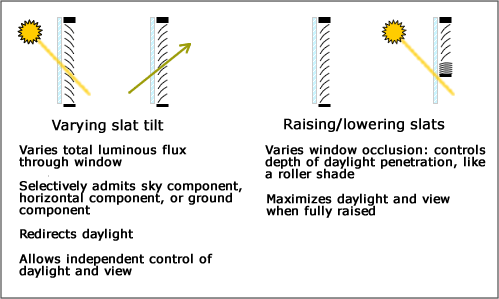
Both the lift and tilt functions can be motorized, but the degree of illumination control provided by the tilt function is far better for DDC applications than that provided by the lift function. As a result, vitually all blind-based DDC systems to date have used the tilt function for automatic daylight regulation, although a few have also used the lift function (in addition to tilt).
Cost
Motorizing the lift function of a horizontal blind requires a relatively expensive drivetrain, but the tilt function can be motorized inexpensively. Further, most horizontal blinds are capable of being retrofitted with tilt motors—and about 75% of office buildings are already equipped with horizontal blinds. Therefore, horizontal blind with motorized tilt is generally the least expensive form of shading device for DDC.
Solar-Optical Properties
Horizontal venetian blinds have two solar-optical properties which make them particularly attractive for DDC applications:
- They can block direct sun while still admitting useful diffuse daylight and permitting an outside view (unless the sun is very low on the horizon, in which case the slats must be fully closed).
- By reflecting some of the admitted daylight upward to the ceiling, they can improve the uniformity of daylight within a sidelit space, increasing the area that can be effectively sidelit.
However, the latter advantage also creates a problem: as its slats are tilted, a venetian blind doesn't just modulate the amount of daylight entering a room—it also changes the daylight's spatial distribution. That complicates the problem of accurately sensing the admitted daylight (unless the sensor is mounted directly on the workplane, which increases cost and is subject to errors from shadowing):
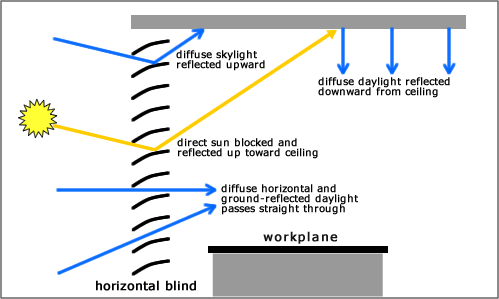
The conventional solution to this problem is to use open-loop control to adjust the blind based on the estimated—rather than directly sensed—daylight level. However, a blind's solar-optical "transfer function" is a complex function of many variables, so open-loop control requires information such as the absolute tilt angle of the blind's slats, the solar elevation angle, and the external daylight illuminance on the plane of the window. This, in turn, substantially increases system complexity.
Motorized Roller Shades
Motorized shades control daylight by varying the effective window aperture, changing the total luminous flux through the window. Many people find shades more aesthetically pleasing than blinds, particularly because of the wide variety of custom shading fabrics available.
Cost
The tubular motors used to motorize roller shades are about as expensive as blind lift motors, but more expensive than blind tilt motors. So costs are generally greater than for motorized tilt-only blinds, particularly in retrofit applications where existing blinds can retrofitted with tilt motors.
Solar-Optical Properties
Motorized shades have two solar-optical properties which are advantageous for DDC applications:
- They are the only shading devices suitable for DDC that offer a maximum visible transmittance (Tv) of 1.0. So they are capable of providing the greatest possible energy savings under low-daylight conditions.
- Like blinds, shades are capable of blocking direct sun from high elevations while still admitting diffuse daylight.
- Unlike blinds, they don't change the spatial distribution of the admitted daylight, simplying implementation of both open-loop and closed-loop control systems.
However, they also have a significant solar-optical limitation for DDC: a partially lowered shade casts a shadow that reduces the depth of daylight penetration; as the shade is lowered further, the shadow expands toward the window. So a roller shade can't limit the brightness near the window—which is where the daylight illuminance is generally highest—without first also reducing the brightness deeper in the room, exacerbating the typical daylight non-uniformity in sidelit spaces.
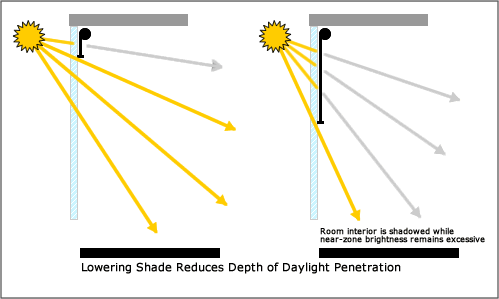
So, while roller shades offer the greatest possible energy savings in low-daylight conditions (due to their maximum Tv of 1.0), their ability to save energy under high-brightness conditions is limited by the shadowing effect described above.
Smart Windows
Two Smart Window technologies are suitable for DDC: ElectroChromic (EC) technology and Suspended Particle Device (SPD) technology. The latter is a proprietary technology developed by Research Frontiers, Incorporated (RFI).
Both EC and SPD technologies can be used in factory-produced Smart Window Glazing Units (SWGUs). According to RFI, SPD technology will also be available in the form of thin, flexible films that can be cut to size by a distributor (or even in the field), and applied to existing glazing units with an adhesive—or even used as a retractable smart window covering for ordinary windows. It may also be possible to retrofit pre-fabricated EC panels or glazing units to existing glazing units; in fact, Lawrence Berkeley National Laboratory (LBNL) used such an approach in testing of a prototype DDC system employing EC windows (Lee et al. 2000, page 4).
Smart Windows are more elegant, both aesthetically and technically, than motorized window coverings, and may very well be the future of automated shading.
On the other hand, current-generation Smart Windows have serious issues which limit their performance in daylighting applications:
- Unlike blinds or shades, current Smart Windows cannot fully block direct sun, even when adjusted to the minimim Tv setting. This can force the use of auxiliary shading (which must be automated to retain the benefits of DDC), increasing cost and complexity.
- The excessive response time of EC windows (at least several minutes) reduces energy savings and complicates manual adjustment of the daylight level.
- Architectural Smart Windows are still not in volume production and are currently far too expensive to be cost-effective strictly on the basis of energy savings, even in new construction. In fact, they may never be cost-effective as energy saving retrofits. Costs are currently about $100 per square foot of glazing, and we project costs at market saturation to be no less than about $10 per square foot—compared to about $2 per square foot for horizontal blinds.
Overall Assessment of Shading Devices for DDC
The following table provides a succinct comparison of these devices for DDC applications.
| Horizontal Blinds with Motorized (but not Lift) Tilt Function | Motorized Roller Shades | EC Smart Windows | SPD Smart Windows | |
|---|---|---|---|---|
| Max. Visible Transmittance (Tv) | ~0.7 | ~1.0 | ~0.6 (for current devices) | |
| Min. Tv | ~0.1 for diffuse daylight; ~0.001 for direct sun | As low as 0.0, depending on fabric | ~0.1 (for current devices) | |
| Response Time | Seconds | Seconds | Minutes | ~1 Second |
| Dynamic Variation in Spatial Solar-Optical Properties | Significant (advantageous for daylight uniformity; disadvantageous for sensing) | Significant (disadvantageous for daylight uniformity; advantageous for sensing) | None | None |
| Ability to Admit Diffuse Daylight While Blocking Direct Sun | Yes | Yes | No | No |
| Net Energy Saving Potential | Highest | Intemediate | Lowest | |
| Cost | Low if leveraging installed base; Medium otherwise | Medium | High | High |
| Technology Maturity | High | High | Low | Low |
Given the high cost and technical limitations of Smart Windows, only motorized blinds and shades appear practical for near-term commercial DDC applications.
Between motorized tilt-only blinds and motorized shades, blinds appear to have a significant cost advantage, particularly in view of the fact that the bulk of the huge installed base of horizontal blinds can be field-retrofitted with tilt motors.
In terms of energy savings, roller shades have an advantage in low daylight conditions because they can be fully retracted, yielding a shading Tv of 1.0 (versus blinds' maximum open-slat Tv of about 0.7). However, blinds save more energy in high-daylight conditions, because shades must be almost completely closed to control the daylight illuminance near the window. Because the bulk of the potential annual energy savings from daylighting occur during high-brightness conditions, shades typically save less energy year-round than blinds.
However, blinds' complex solar-optical properties make it difficult to fully exploit their energy saving potential. Due to the limitations of conventional sensor technology (discussed below), blind-based DDC systems must use a complex control protocol (which adds cost and complexity) and/or restriction of the slat-tilt operating range (which reduces savings) in order to ensure an acceptably low risk of glare.
Daylight Control Protocol
As with the daylight harvesting function of dynamic daylghting, the DDC function can also be implemented with either closed-loop or open-loop control. Each approach presents different challenges for DDC.
Closed-Loop Systems
In a closed-loop DDC system, the control signal that determines the setting of the shading device is based on the actual interior daylight level to be controlled (for example, the daylight illuminance on a desk), and the shading is adjusted to minimize the difference between the actual and desired interior daylight levels.
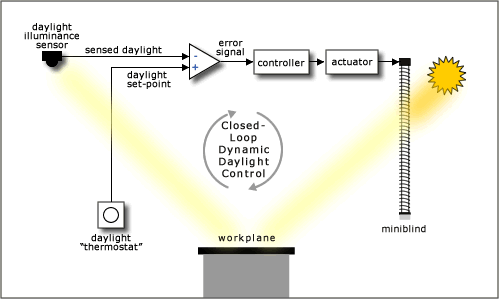
The earliest DDC systems were closed-loop systems. For example, U.S. patent 3,294,152 (1966) disclosed a motorized roller blind actuated by an inward-facing photocell located inside the sidelit space, and U.S. patent 3,646,985 (1972) disclosed a motorized blind actuated by an outward-facing photocell inside the sidelit space. More sophisticated blind-based systems, capable of blocking direct sun while admitting diffuse daylight, were disclosed in U.S. patents 4,396,831 (1983) and 4,622,470 (1986). However, none of these systems was intended to be used with daylight-harvesting lighting controls.
If the controlled variable (in this case, the daylight level at a selected point in the sidelit space) can be accurately sensed, closed-loop systems provide the best possible performance with the simplest control hardware. Unfortunately, in a DDC system used for daylighting applications, accurately sensing the daylight level presents two major problems:
- The artificial illumination problem: avoiding errors due to varying levels of artificial illumination.
- The geometry problem: ensuring that the sensor signal accurately represents the daylight illuminance at the desired point in the sidelit space.
The Artificial Illumination Problem
When DDC is used for daylighting applications, the levels of both daylight and artificial light vary as the DDC and daylighting harvesting systems do their jobs. This variation in artificial illumination creates a serious problem for closed-loop DDC: unless the sensor is located, oriented, or shielded so that it doesn't sense any artificial illumination, the system will be "confused" by the operation of the daylight-harvesting lighting control.
Unfortunately, locating, orienting, or shielding the sensor to avoid artificial illumination exacerbates the geometry problem (as discussed below).
This leaves only one conventional solution to the problem of avoiding errors due to artificial illumination: putting the DDC and lighting systems under common control. Then a conventional, downward-facing WorkPlane Illuminance (WPI) sensor can be used to sense the total (natural plus artificial) illumination, and the system can adjust the shading and lighting systems according to a predetermined algorithm to provide closed loop control of the total illumination.
However, as discussed below, this doesn't completely avoid the geometry problem.
The Geometry Problem
To avoid the artificial illumination problem, some early closed-loop DDC systems used a shielded, outward-facing photocell, mounted directly on the inward side of the shading device, to sense just the admitted daylight. However, because such a sensor "sees" daylight from a different perspective than the workplane sees the daylight, its output can't accurately track the actual daylight illuminance on the workplane—especially under changing conditions.
From a geometric standpoint, the ideal sensor for closed-loop DDC would be positioned and oriented exactly like the occupants' eyes, while the next-best alternative might be a sensor located directly on the workplane (e.g. the desk).
Unfortunately, in a typical non-residential building, permanently installed head-level or desk-level sensors aren't practical. Portable, wireless sensors that can be placed on a desk are a possibility, but that substantially increases overall cost.
For this reason, closed-loop DDC systems generally use ceiling-mounted sensors to sense the daylight reflected from the workplane. While ceiling-mounted daylight sensors aren't as accurate as daylight sensors mounted directly on the workplane, they can usually provide good DDC performance if the workplane (and other parts of the room within the sensor's field of view) act as diffuse reflectors that scatter the incident daylight equally well in all directions.
However, there is one situation in which a ceiling-mounted daylight sensor cannot provide good closed-loop DDC performance: when the shading device is a venetian blind operated over its full slat-tilt adjustment range. Depending on the slat tilt angle, a venetian blind can reflect daylight upward toward a ceiling-mounted sensor. Even more significantly, it can allow ground-reflected daylight (which is much larger than skylight in clear weather without direct sun) to directly illuminate the sensor:
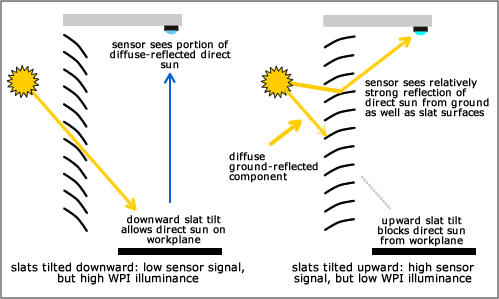
As a result, the output of the sensor can be a stronger function of the slat tilt angle than of the daylight illuminance on the workplane. This significantly complicates the use of ceiling-mounted sensors with venetian blinds.
Open-Loop Systems
In an open-loop DDC system, the control signal that determines the shading setting isn't a function of the interior daylight level at all. Instead, it's a function of exterior conditions. The system adjusts the shading to a setting that it thinks will yield the desired interior daylight level—but doesn't sense that level directly.
One of the earliest practical open-loop DDC systems was the motorized venetian blind disclosed in U.S. patent 5,532,560 (1996), which employed an exterior daylight sensor mounted outside the sidelit space.
The problem with open-loop control is that the daylight level at the desired point in the sidelit space can be a very complex function of variables such as the solar elevation and azimuth angles, the solar-optical properties of the shading device, the room geometry, and the reflectance of the room surfaces. This is especially true when the shading device is a Venetian blind, which modulates the spatial distribution—as well as the intensity—of the admitted daylight as a function of the slat tilt angle.
As a result, open-loop systems generally need more complex hardware and a more complex set-up or commissioning process than closed-loop systems. Consider, for example, the sensor hardware required for accurate open-loop DDC:
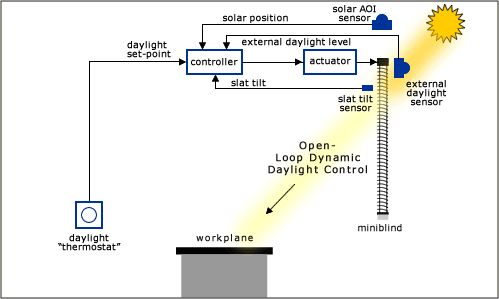
The added complexity relative to closed-loop control is offset by the fact that the sensors can be shared among multiple windows. For example, some open-loop DDC installations use a single, roof-mounted sensor array to measure the daylight illuminances on each facade, as well as the solar elevation and azimuth angles, for the entire building. However, sharing the sensor information requires a networking infrastructure, and set-up and commissioning of such a system can be very complex—particularly if there are structures or other nearby buildings that can cause shadowing.
Hybrid Control
One way to mitigate some of the issues with exclusively closed-loop and exclusively open-loop control is to use a hybrid approach. For example, an open-loop scheme can be used to infer the presence of—and then block—direct sun based on time of day, day of year, and window orientation, while a closed-loop approach can be used to adjust the shading at other times. The ground-breaking dynamic daylighting systems developed at LBNL in the 1990's used such a hybrid approach with Venetian blinds, with excellent results.
Control Objectives
In addition to the choice between closed-loop and open-loop control—which determines how the DDC control signal is generated—the designer/specifier of a DDC system must define exactly what the system is supposed to do. There are many possible DDC control rules, e.g.
- Maintain a desired average daylight illuminance over the daylit area
- Limit the maximum daylight illuminance over the daylit area
- Minimize the ratio of the near-zone to far-zone illuminance
- Minimize the frequency of shading adjustments
The choice of control objectives(s) is typically a tradeoff between a desire to maximize the average daylight level (and, hence, the lighting savings from daylight harvesting) and a desire to minimize the risk of annoyances to the building occupants (e.g. due to glare or excessively frequent shading adjustments) and solar heating loads on the building's HVAC system. Optimizing this trade can require very complex algorithms and plenty of information other than just the daylight levels in the daylit space, and obtaining this information can require sensors or interfaces that drive system cost. For example, an "optimum" algorithm can require information on the artificial lighting level and the current and predicted thermal loads on the building's HVAC system, as well as the spatial distribution of the interior daylight level.
Our own research shows that daylight harvesting cost-effectiveness (i.e. the ratio of system cost to the value of annual energy savings, including both lighting and HVAC loads) is maximized* with a simple DDC control rule: keep the shading as open as possible without glare or excessive brightness. The challenge in implementing such a control rule is in deriving a signal that accurately represents the risk of glare and excessive brightness, which are subjective quantities.
Integration and Networking with Other Building Systems
As with any other building system, integration of the various portions of a dynamic daylighting system into a whole-building network can facilitate performance monitoring and fine-tuning. But there are even more important reasons to pursue integration and/or networking of dynamic daylighting equipment:
- With closed-loop and hybrid control, integration between the shading and lighting systems is necessary to overcome "the artificial illumination problem" discussed above.
- With open-loop control, networking dramatically reduces total system cost because it enables the required sensors (e.g. sun-position and external daylight illuminance sensors) to be shared across multiple zones.
So some form of integration between zones is effectively mandatory with conventonal dynamic daylighting technology.
Integrated Architectures
Many different integrated architectures are technically possible, based on variables such as:
- Allocation of control functions (e.g., distributed control versus centralized control)
- Network topologies (e.g., star versus ring)
- Network and interface standards and protocols
However, the scope of practical architectures is constrained by four key considerations:
- Each shading control is typically located near a window, while each lighting control is typically located near a luminaire. This means that some kind of remote communications—either wired or wireless—is necessary to integrate the two functions.
- The data rate required to control the shading and lighting functions is negligible. Therefore, standards such as TCP/IP over Ethernet—or even Bluetooth—are overkill to interface with these devices. Instead, the most cost-effective interface solution is a lower-cost, lower-data-rate standard such as ZigBee or even direct discrete or analog control.
- Most buildings already have an Ethernet-based Local Area Network (LAN). That existing network is the logical choice for linking functions or processes that span several rooms in a building.
These considerations naturally lead to a bi-level architecture, consisting of multiple Room-Area Network's (RAN's) linked together by a Building-Area Network (BAN)—with the BAN typically riding on the existing LAN:
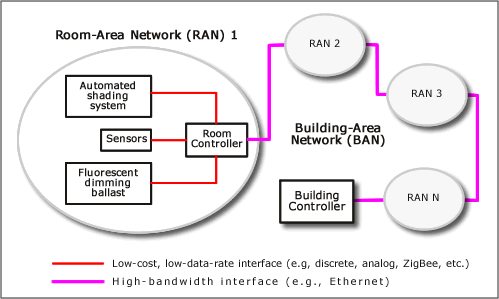
However, many variations are possible, particularly in how the RAN is implemented.
Room Area Network (RAN)
Each RAN spans a controller, at least one shading device, and at least one dimmable electronic ballast. Optionally, thermostats and local HVAC units can also be included. The controller can be a dedicated device or an application running on an existing PC (although, due to configuration management and stability considerations, the latter may not be optimum). Within this general framework, though, there are many possible variations in exactly how these components are connected.
One obvious approach is to base the RAN on a subset of the Ethernet protocol. In fact, there are single-chip solutions that provide both the Medium Access Control (MAC) and Physical (PHY) layers of the Ethernet standard. However, as mentioned above, Ethernet—especially wireless Ethernet—is overkill for the shading and lighting functions.
Instead, the most cost-effective approach is to use less expensive, less powerful interfaces wherever possible within the RAN. One approach is to use dedicated point-to-point interfaces in a star topology, as shown in the following chart:
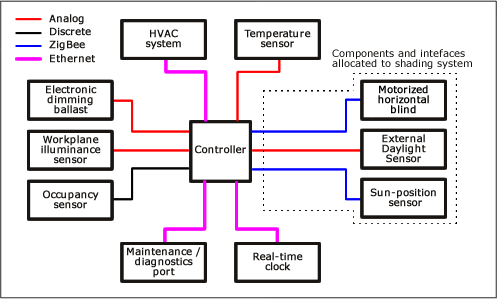
This is the least expensive approach, because it allows the most cost-effective interfaces to each device. On the other hand, it requires a mix of standards and complicates application software development.
The other extreme is to use a single standard capable of peer-to-peer operation and distributed control, like LonWorks (wired) or Zigbee (wireless):
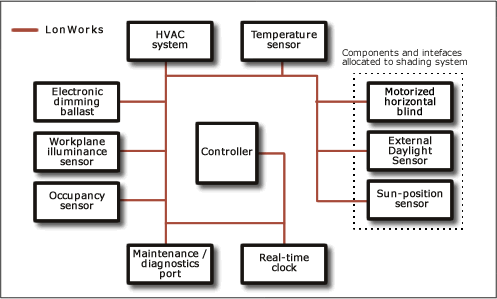
This approach enables a flexible topology and simplifies the process of developing control software. However, the hardware is substantially more expensive than in the preceding approach. The added cost isn't just due to the overhead associated with implementing the standard, but also due to the fact that simple analog nodes (such as illuminance sensors, which provide an analog output, or dimmable ballasts, which often use a 0-10v analog input) require A/D or D/A conversion—along with other "bit twiddling"—to connect to such a network. Fortunately, single-chip solutions are available to connect such sensors (as well as sensors with discrete on/off outputs) to a LonWorks network, but the conversion overhead does add to the overall price.
Sharing Devices Across the Building-Area Network (BAN)
Three of the RAN nodes shown in Chart 3—the real-time clock, the external daylight level sensor, and the sun-position sensor—could be shared between multiple RAN's (i.e., multiple rooms) across the BAN, yielding substantial cost savings. Such a configuration looks like this:
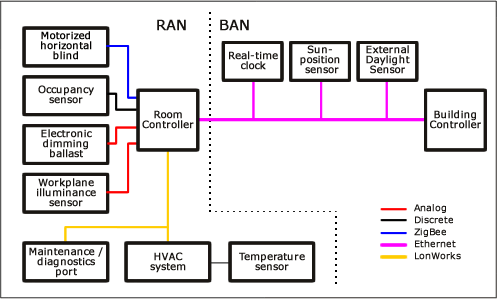
Need for Interoperability
Obviously, an integrated/networked architecture requires that the various devices be interoperable. Unfortunately, there is as yet no single "industry standard" protocol for how building subsystems should work together; instead, there are a variety of competing standards. At the lowest level, there's discrete, 0-10 VDC analog control, and DALI (Digital Addressable Lighting Interface). At the networking level, there's Ethernet, ARCnet, LonTalk, and MS/TP over twisted-pair wiring; wireless options include Zigbee and Bluetooth 4.0. Above that, at the control/application level, there's BACnet, LonWorks, and several others.
Until an industry standard emerges, the only way to sidestep the interoperability issue is by distributing (or at least pre-specifying) complete "system-of-systems" solutions from individual products that are known to be compatible.
Exploiting the Tradespace
Because dynamic daylighting systems have so far achieved only negligible penetration, the market hasn't yet voted on the best way to exploit the available tradespace. But prototype DDC systems based on conventional technology—and the relatively few systems that have been installed in operating buildings—do follow some general trends, as discussed in The Conventional State-of-the-Art.
Unfortunately, these systems prioritize integration with other building systems, ancillary features such as wireless remote control, and/or shading aesthetics at least as much as they prioritize daylighting cost-effectiveness, so they don't represent the most cost-effective way to implement dynamic daylighting with conventional technology. However, a hypothetical DDC system based on conventional technology that does prioritize daylighting cost-effectiveness is described in A Benchmark Conventional Configuration.
Summary of Key Points
- The conventional state-of-the-art in dynamic daylighting is to combine the shading and lighting functions into an integrated system
- Beyond this fundamental concept, the design tradespace offers four major variables:
- Lighting control configuration, i.e. the choice between switching-only, dimming-only, and dimming-and-switching lighting control. Given the high cost of conventional automated shading technology, dimming-and-switching control is almost always the most cost-effective configuration for dynamic daylighting
- Shading configuration. Smart Window technology is still far too expensive to be viable for retrofit applications, so the only practical choices are motorized blinds and shades
- Control protocol, i.e. the choice between open-loop, closed-loop, and hybrid open/closed-loop control. With conventional sensor technology, hybrid control appears to be the most cost-effective approach
- Integration and networking with other building systems. Conventional dynamic daylighting effectively requires integration between the shading and lighting functions, and many different integrated architectures are possible. The most cost-effective approach is a bi-level architecture which uses low-bandwith interconnections (e.g. Zigbee-class) within each daylit zone and high-bandwidth (e.g. Ethernet-class) between zones
- The Conventional State of the Art discusses how these design variables have been addressed in real systems, while A Benchmark Conventional Configuration describes a hypothetical, maximally cost-effective system

